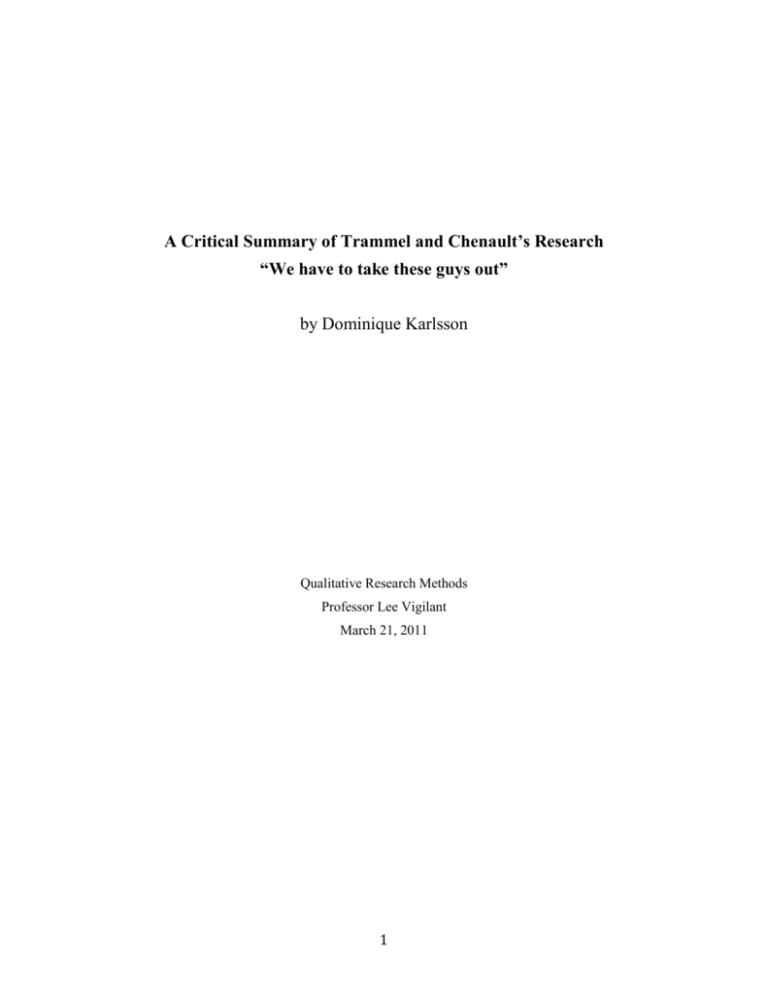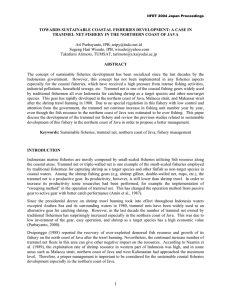We Have to Take These Guys Out
advertisement

A Critical Summary of Trammel and Chenault’s Research “We have to take these guys out” by Dominique Karlsson Qualitative Research Methods Professor Lee Vigilant March 21, 2011 1 “1300 offenders convicted of Lewd Acts with a Minor enter California prisons each year and (on average) eleven inmates are killed because of an assault each year” (Trammel and Chenault 2009:335) The paper “We have to take these guys out”: Motivations for Assaulting Incarcerated Child Molesters is a serious look at the reasoning behind vigilante punishment within prisons against child molesters by other prisoners. Over the course of this study, Trammel and Chenault identified two purposes to violence directed at child molesters. First, the primary stated reasoning was that child molesters are considered dirty and incorrigible, and thus needing additional punishment beyond simple incarceration for their crime, or death as a preventative against future acts. The researchers also believe that the behavior serves a secondary purpose of distancing the rest of the incarcerated prisoners from the “dirty” prisoners who have committed such crimes. When so-called “dirty” prisoners are assaulted, they frequently are placed into protective custody and thus removed from the general prison population. Even if they are not physically removed, they are socially distanced by the behavior of the other prisoners. This is a fascinating study, with significant implications into human behavior. How the study of this behavior came together is important to understanding this behavior and for assessing whether the researchers’ work is accurate and reliable. For purposes of analysis, R. Burke Johnson’s guidelines on evaluating the validity structure of Qualitative Research will be used to breakdown the research. General Validity Over the course of the article little Negative Case Sampling is mentioned. Two notes are included: There is a brief explanation that no prison violence is used by the female inmates, despite their having strong opinions of what should be done to child molesters. Additionally, there is reference in the section that discusses race to African Americans being blamed “for giving child molesters a pass” (Trammel and 2 Chenault 2009:346). Donald, a 36-year old African American, explains why the enforcement against child molesters is separated along racial lines by norms, but not why African Americans might be less likely to follow the expectations of enforcement. Additional information on whether some or all African Americans do not hold the same perspective on violence against child molesters would be valuable perspective. The study also offers only a partial Reflexivity Statement. Trammell and Chenault do not disclose any pre-existing biases. There is however a discussion of the inherent challenges in working with prison populations in order to keep identities confidential, gain and maintain trust, and to not discuss any recent crime activity (Trammel and Chenault 2009:336). Further, they explain that their data was not gathered from a random sample, but rather a snowball sample using interviews from parolees within two months of release. In order to compensate for these limitation and for not being able to interview current prisoners, the researchers focus their study on the qualitative description of the former inmates’ narrative descriptions of their behavior (Trammel and Chenault 2009:341). Further, in reference to the assertion that correctional officers were implicitly supportive of the prisoners’ actions, they acknowledge “Obviously, there is no way to verify if this is true” (Trammel and Chenault 2009:343). Descriptive Validity Both Data Triangulation and Investigator Triangulation were used during the course of the research to strengthen the quality of data gathered. Data Triangulation took the form of using a background of theory combined with live interviews. Additional interviews, perhaps with sources such as the prison guards or victims of violence, might have offered a more nuanced understanding of the phenomenon as a whole. Because the article is written by two researchers, it is likely that Investigator Triangulation used, however it is not specified. In several of the sections detailing the interview process, the narrative pronoun used switches from we to I, but it is not clear if this is significant or a quirk of the writing style. Overall, this combination of data gathering and verification is a reasonably thorough analysis. 3 Interpretive Validity This study makes extensive use of Low Inference Descriptors to illustrate their findings. This includes short phrases such as “dirty”, “marked”, and “taken out”, which are used throughout the paper, as well as lengthier quotations such as this explanation by John, a Hispanic male who served three years in prison, of the motivations behind the violence: Baby killers or people that mess with kids. They can’t be cured or anything, so we’re just trying to remove them from the picture. (Trammel and Chenault 2009:343) The usage of Low Inference Descriptors is one of the strengths of the paper, as it offers interesting insight into the mentality behind the behaviors. Theoretical Validity It is debatable if the fieldwork is sufficiently lengthy to properly qualify as Extended Fieldwork. The interviews were done during the period 2005-06, but the exact number of days or months of the study was not specified. Additional time of study would have been helpful to ascertain whether the behavior and attitudes were ongoing or specific to a short period of time. At the beginning Theory Triangulation was utilized by including a section of literature review (Trammel and Chenault 2009:336-338), which included works by Mills on motive talk, Scott and Lyman on excuses and justification for bad behavior, Scully and Marolla on justifications by rapists, and others. Trammel and Chenault clearly outline these works, and explain why their theories are helpful but insufficient to explain this particular behavior. Doing so offers an excellent basis for the research while offering an explanation for the placement and need for their new research. A total of 40 men and 34 women were interviewed, though only data from the male interviewees was used for the study conclusion. Across the male parolees the results were fairly uniform indicating that they had been able to successfully apply Pattern Matching to their data. Additional study of the information from female interviewees would be helpful for context and comparison in future research. 4 There is no indication that Participant Feedback was used in this study. Usage of Participant Feedback would have been helpful in correcting for errors in interpretation, but the researchers perhaps did not have the opportunity to do so. It is also possible that the feedback to any interpretation predicating different underlying assumptions than those assumed by the parolees would be overtly negative and somewhat hostile. For example during their interviews, one of the parolees showed a strong reaction when the interviewer did not answer as expected: Jimmy: If someone raped your kid, you’d want me to kill him right? Interviewer: I don’t know if I’d want them killed. Jimmy: Don’t pull that PC shit with me, you’d want them dead. We all would. (Trammel and Chenault 2009:344) Additionally, it can be assumed that the article went through a thorough Peer Review as part of the submission to the journal Symbolic Interaction. This is a critical step in searching out errors in analysis. Internal and External Validity Overall the researchers did work in the mode of Researcher as Detective, utilizing the strategies listed above to analyze their data and put it together in a way that adequately analyzes the material but does not overreach in its conclusions. Their usage of Data Triangulation, including Methods, Investigator, and Theory Triangulation has allowed them to consider the investigation from a variety of angles. The limited the scope of their conclusions includes a descriptive analysis of what these particular parolees have constructed as their narrative for acting, but specifically does not attempt to apply their findings to any other larger groups, including the California prisoner population as a whole. Instead they have created a self-contained analysis that could be used a springboard for further research. The researchers clearly state that because their method of data gathering is not random, they do not consider the research to be representative of either the general prison population in California or prisoners as a whole (Trammel and Chenault 2009:340). Since Trammel and Chenault are not looking to generalize 5 their findings, there is no need to consider External Validity when evaluating this research (Burke 1997:164). Conclusion Overall, the research for this paper was solidly grounded and seems to be a good example of qualitative research. Additional research on the same subject over a longer time or including interviews with female prisoners or with prison guards would be helpful in gaining further insight into the behavior. By making strong use of Low Inference Descriptors combined with Methods Triangulation, Trammel and Chenault have provided a worthwhile basis for their own work and for future research. 6 REFERENCES Johnson, R. Burke. 1997. “Examining the Validity Structure of Qualitative Research.” Cases in Qualitative Research:160-165. Trammel, Rebecca and Scott Chenault. 2009. “’We Have to take these guys out’: Motivations for Assaulting Incarcerated Child Molesters.” Symbolic Interaction, Vol. 32, Issue 4:334-350. 7







